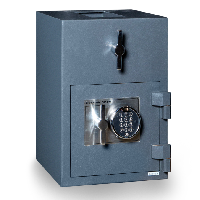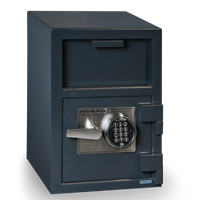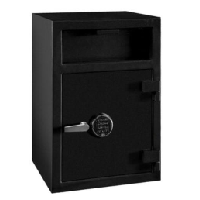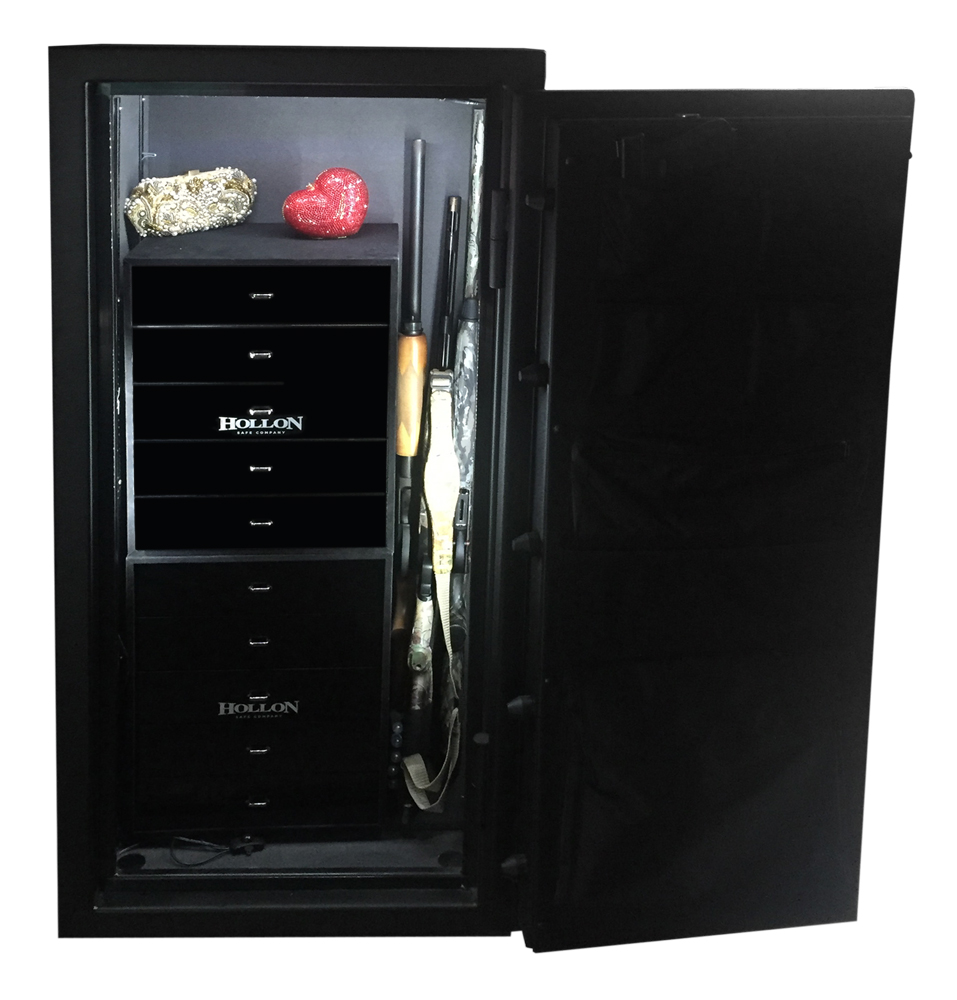Gun safes are designed with two purposes in mind:
safety and protection from theft and fire. While gun safes are not yet required by law, there may be laws in your state that will hold you responsible if a minor is injured or killed due to the failure to lock up your guns safely. This makes purchasing a gun safe the smart option for those who own guns.
Types of Safes
There are two main categories of gun safes:
pistol safes and rifle and shotgun safes. Pistol safes come in two styles, allowing you to choose a smaller chest style or the larger cabinet style. The chest style is often designed to hold one gun and will secure the gun and protect it from fire. The cabinet style is larger and can accommodate multiple guns. Rifle and shotgun safes are larger to accommodate the length of these guns, protecting them from both fire and burglary, while keeping them out of reach. Some models have racks and shelves.
Fireproof Rating
As you consider the right gun safe, you need to look at the fireproof rating it carries. When you look at the fireproof ratings, you will see a time limit and a temperature listed. The time limit is the duration at which the temperature listed will be maintained within the safe when there is a fire. Your safe should keep the internal temperature at no more than 350 degrees to keep your guns and ammunition safe.
Burglary Rating
Many gun safes also have a burglary rating. This rating is also listed in time increments, letting you know how long it would take an experienced person to break into the safe with locksmith tools. The longer the time, the better protection you have.
Locking Mechanisms
The final aspect you need to consider as you look at gun safes is the locking mechanism used. You can find mechanical locks, mechanical combination locks and electronic keypad locks. The preferred type of locking mechanism today is the electronic keypad, allowing users to open it with the input of a specific code. Many can even grant access via multiple codes for more than one user.
Gun Safe Disection:
I have many customers wanting me to tell them “Which is the best gun safe”.
Well, that is a tough question. Because most manufacturers produce several gun safe lines. A good, a better, and
a best series. Some manufactures make all three series very good quality. Some will often produce a VERY low end
model and sell it to a big box retailer. All from the same company. So you see it is difficult to say that ALL the gun safes that come from XYZ manufacturer are the best. When only their top series is great and the rest are overpriced metal boxes.So I would like to break down the components of a gun safe into several sections. Quality of steel, fireproofing, lock, relocker and hardplate, and warranty.
Gun Safe manufacturing:
I’m not going to beat around the bush on this one. China is the country of choice. Even the models that say “Made in the USA” are made in China. The box and bolts are made in China and shipped to California where they put on the lock and a liner and call it “Made in the USA”. Cannon, American Security, Browning, Liberty, and others are all made in some form in China. Though they may make a very high end model here in the USA. You will be paying $4,000 and up for these units. The strange thing too is that no other country really makes gun safes. Just China. Don’t be heart broken its a fact of life in the USA.
Gun Safe steel comes in several thicknesses. Often refered to as gauge. Steel gauge is thicker the smaller the number. So a 10 gauge is thicker than a 12 gauge. Sounds odd but that is how its measured. There is also a term know as “B-Rated” which means they use 1/2 inch plate steel on door and 1/4 inch plate steel on body. This is much thicker than a 10 gauge steel. A 10 gauge thickness is just under 1/8 inch. I prefer the 10 gauge steel models. Though there are some very good 12 gauge models available. Anything thiner than a 12 gauge I stay away from. Because the wall of the safe becomes flexible at this point. Too flexible for me. I have crow barred models that you can get at big box retailers that don’t tell you the gauge of steel. When I did, the wall let the bolt slip out. The bolt really didn’t bend. It was a good bolt but the rest of the safe did. That being said, pay attention to the steel thickness.
Gun Safe fireproof material:
Normally it is UL listed fireboard. Almost all the manufactures use the same stuff. However, a couple of companies do use a concrete fireproof mix. This is normally only on the really high end models. I have heard of 1 company using ceramic. Which is great stuff for fireproofing but too fragile for a gun safe. Stay away from it. Because it can crumble inside the door but you will not see it.
Gun Safe Lock:
Dial brands like LaGard and Sargent & Greenleaf are very good. But its important to point out that some are made in the USA and others are made in overseas in China. Your gun safe that was made in China will have one of these locks. There are other brands also that are import from Asian countries but I prefer the LaGard or S&G as Sargent & Greenleaf are often called. If it doesn’t say the lock is UL listed. DON’T buy the safe. Keypads are great if you are keeping a gun inside for home security. Only a keypad will get you inside quick enough. Its very easy to open and convient. Worth money if you are getting in and out quickly. The negative is that it is a 9 volt battery operated devise with a maximum life cycle around 15 years. It is easy to replace by your local locksmith.
Gun Safe Relocker and Hardplate:
You will not see either a relocker or hardplate on the safe. Its in the door and hidden. You will have to ask or it will be in the brochure. If its not listed then it doesn’t have it. That is getting a little too cheap in quality for most gun owners. All UL listed Group II locks have a relocker automatically. What does a relocker do? Well, after a thief takes a sledge hammer and bangs off the dial from the front of the safe. He will often hammer a screw driver down the lock hole to try and knock the lock off the interior of the safe. This fires the relocker. (It will take a locksmith to get you into the safe). Hardplate keeps the expert thief with a drill out of the safe. Hardplate covers just the lock and must be melted in order to get past it and into the lock. This doesn’t happen very often that a thief has a blow torch or something to defeat it. Its more for bragging rights by the manufactures.
Warranty:
Lifetime fire warranty is normal in the industy. If you have a fire, they send you a new one for free. 1 year parts and labor is also normal. Though some are offering a Lifetime Burglary warranty now. If you get your safe broken into in a burglary or just destroyed the will repair or send a new one to you. However, some are offering a “Lifetime Warranty on Everything”. Stay away from that fairy tale. Those are fly by night manufactures that will be out of business within a year to two. (Sounds really great though)





